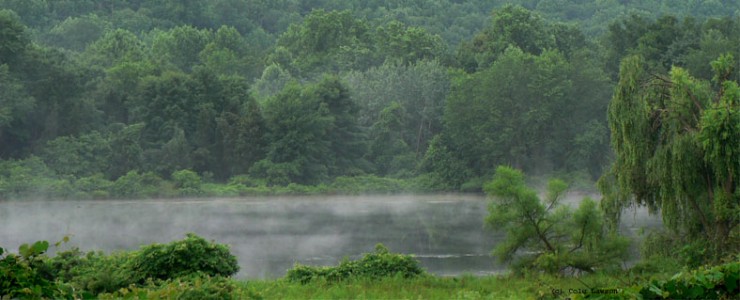Cherry Valley Wildlife Refuge lies within a region characterized by major seasonal changes from hot, humid summers to potentially severe winter cold. Resembling open meadows, the mid-Atlantic calcareous fens in Cherry Valley are nestled in the Pocono Mountains among bogs, swamps, and hillside seeps (Levin & Lehigh Valley Audubon Society, 2008). These rare peatlands consist of limestone bedrock with mineral-rich water supplied by seeps and springs (The Nature Conservancy, n.d.). Layers of peat retain nutrients, restricting their availability to plants. However, deposition of calcium and magnesium results in elevated soil pH, supporting a wide range of sedge grasses, reeds, and other low-growing vegetation (The Nature Conservancy, n.d.). The high primary productivity in a fen supports great diversity in limited populations of small mammals, fish, birds, and larger predators (Turner & Gannon, 1995). According to The Nature Conservancy (n.d.), “Cherry Valley is home to 85 rare species, including the federally threatened bog turtle, federally endangered northeastern bulrush, and dwarf wedge mussel.”
Title Photo Credit: Friends of Cherry Valley. friendsofcherryvalley.com
Native and Invasive Species Interactions

Historically, these types of open wetlands were maintained by populations of beavers and bison, as well as occasional fires (US Fish and Wildlife Service, n.d.). In the absence of these components, area fens are threatened by successional and non-native vegetation. Invasive species, such as purple loosestrife, see little environmental resistance in the competition for space (Ecology and Management of Invasive Plants Program, n.d.). These non-native plants may succeed in altering the fen’s structure and function as they can quickly crowd out native plants. Native animal species experience higher environmental resistance as primary food sources become scarcer. Vegetative succession also increases environmental resistance for native endangered species while lowering resistance for predators hunting along encroaching woodland edges (US Fish and Wildlife Service, n.d.). The issue is exacerbated by conversion and fragmentation of these wetlands for other land uses.
FEN NUTRIENT CYCLING AND HUMAN ACTIVITY
Fragmentation and conversion of surrounding land are among the many factors determining nutrient cycling in a fen. Other factors include the geology, topography, and hydrology. According to The Fen Management Handbook (2011), fens are fragile habitats where nutrient cycling involves only small amounts of available inorganic nutrients. This means the ecosystem is more vulnerable to changes such as water level fluctuations and increases in nitrogen or phosphorus. Land use near Cherry Valley NWR indicates potential for undesirable nutrient enrichment from agricultural sources. As of 2008, 16 percent of parcels were designated as agricultural, including cropland and various livestock farming (US Fish and Wildlife Service Economic Division, 2008). Increased use of chemical fertilizers may concentrate nitrates in groundwater feeding the fens, and livestock farming is a source of phosphorus enrichment. Other land use issues indicated by the US Fish and Wildlife Service Economic Division assessment (2008) are the growing residential neighborhoods, industrial sites, as well as road networks. In addition, the proximity of New York City and Philadelphia increase the probability of development and atmospheric nitrogen enrichment. A product of burning fossil fuels, nitrous oxide is a key pollutant in fens. It is a source of nitrogen and other components that react to acidify fens (The Fen Management Handbook, 2011). Many fen ecosystems in the region were lost as a result of pollution and drainage for various types of development.
RESTORATION AND MANAGEMENT
According to Nature Conservancy (The Nature Conservancy, n.d.), the most pressing threats to limestone fens and other ecosystems in Cherry Valley are residential development and the spread of non-native species. Examination of these issues, coupled with the rarity of Cherry Valley habitats and species, concluded with the 2008 establishment of Cherry Valley National Wildlife Refuge. Basing actions upon previously addressed environmental impacts, Nature Conservancy works with US Fish and Wildlife Service restoring and maintaining Cherry Valley’s fens. First, area landowners are advised of protection options (The Nature Conservancy, n.d.) to address root causes of nutrient enrichment (The Fen Management Handbook, 2011). Next, on-going land acquisition plays a crucial role in developing wildlife corridors and buffer zones to manage nutrient pathways (The Fen Management Handbook, 2011). Finally, eliminating invasive species from the area serves to restore natural functions (The Nature Conservancy, n.d.). Managing fens is part of the larger plan to preserve habitat and provide corridors along the Kittatinny Ridge.
References
Ecology and management of invasive plants program. (n.d.). Purple loosestrife. Retrieved from http://www.invasiveplants.net/plants/purpleloosestrife.htm
Levin, J., & Lehigh Valley Audubon Society. (2008, April 9). Cherry Valley National Wildlife Refuge. Retrieved from http://www.lehigh.edu/~bcm0/lvas/Cherry%20Valley.htm
The Fen Management Handbook (2011), Editors A. McBride, I. Diack, N. Droy, B. Hamill, P. Jones, J. Schutten, A. Skinner, and M. Street. Scottish Natural Heritage, Perth.
The Nature Conservancy. (n.d.). About Cherry Valley in Pennsylvania. Retrieved from http://www.nature.org/ourinitiatives/regions/northamerica/unitedstates/pennsylvania/placesweprotect/cherry-valley.xml
Turner, M., & Gannon, R. (1995). Types of Wetlands and Their Roles in the Watershed. Retrieved from http://www.water.ncsu.edu/watershedss/info/wetlands/types3.html
US Fish and Wildlife Service Economic Division. (2008).Economic assessment for a proposed Cherry Valley National Wildlife Refuge. Retrieved from http://wwwfws.gov/economics/DiscussionPapers/CherryValleyNWRStudy_PublicDraft_Econ.pdf
US Fish and Wildlife Service. (n.d.). Bog Turtle – Clemmys muhlenbergii. Retrieved from http://www.fws.gov/northeast/pdf/bogturtle.pdf

